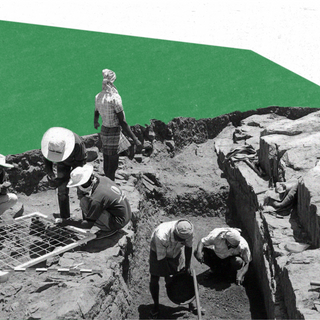
To Keep Our Coastal Cities From Drowning in Floods, We Have to Reimagine Land Use
When development pushes out the marginalized, and sacrifices wetlands, cities like Chennai become more vulnerable to floods.

The Pallikaranai marsh in Chennai teems with lush tall grass that sways gently against the rush of vehicles on the expressway flanking it. Once, the marsh stretched on ad infinitum; today, a ring of densely packed buildings brackets its horizon, its pools of water reflecting nothing but the undulating telephone wires overhead. In a city built almost entirely on wetlands, this is the only major surviving marsh today.
Wetlands serve a critical ecological function in coastal cities. They prevent erosion of coastlines and increase resilience to disasters by acting as flood sinks. With all but one of the city’s major wetlands erased from its topography, Chennai’s inhabitants face ever-increasing flooding risks — a situation that the recent Intergovernmental Panel for Climate Change (IPCC) report has confirmed.
The devastating 2015 Chennai floods are one such “price” residents paid for wetland destruction. Meanwhile, untrammeled “development” continues at the expense of marginalized populations who don’t have any agency to influence what happens to the landscapes they call home.
The Pallikaranai marsh, therefore, represents everything that is wrong with the history of urban development in coastal cities. Its shrunken size is testament to what a city defined by its relationship with water has done to itself. Understanding how this came to be, requires a rethink of value systems over ownership and beauty.
Poramboke and Property
As natural landscapes become a blank slate for development, the commons are sacrificed. The commons, in environmental parlance, refers to everything that the earth has to offer for all to share. At some point in history, societies began to privatize the commons — dividing up land, water, and soil into legally represented pockets in the form of title deeds.
“The fetishism of property through title determines what is allowed to stay and what has to go,” says Karen Coelho, an expert in urban ecology from the Madras Institute of Development Studies.
In Tamil Nadu, the vocabulary around the commons saw a particular evolution. During colonial rule, the commons represented land that could not be bought or sold, that fell outside the revenue register, could not be built upon, and did not make sense to an administration bent upon reconfiguring land in the language of property.
That is, areas such as lakes, wetlands, and floodplains were referred to as wasteland for all intents and purposes: poramboke, or land outside the revenue register. This shift in understanding had profound implications for how the city was designed, built, and inhabited forevermore.
This vocabulary of modernization and development in the 20th century allowed for “very little tolerance in leaving open spaces intact,” explains Pushpa Arabindoo, an expert in urban geography and design from University College London. In the 1970s, when the World Bank provided funding for housing development, most of the commons that were no longer seen as “useful” in Chennai were built over. These included all the wetlands, which were filled in to establish many landmark structures associated with the city today.
“The conversion of reservoirs into the ‘wasteland’ imaginary triggered the fact that these were better off as development sites than left to be feeders for rainfall or rainwater harvesting,” Arabindoo explains.
Related on The Swaddle:
Uttarakhand Floods Worsened by Rampant Development in Eco‑Sensitive Areas, Environmentalists Say
Who Are The Encroachers?
As governments searched for ways to transform poramboke into property, the relationship between the land and people began to change, and the narrative of “encroachment” entered the economic lexicon. As environmental activist and journalist Nityanand Jayaraman explains, “encroachment” has two different meanings: “In the legal register, encroachment is a structure that does not have a license. In nature’s register, it is a structure that ought not to be where it is,” he says. How the city preempts and responds to disasters like floods depends on which meaning is taken into consideration. In most cities, it is the legal meaning — which means that the poor are evicted from sensitive lands even as similar topography is reshaped for corporate use.
Hence, commercial real estate continues to be developed over ecologically sensitive land, while the poor are “resettled” en masse from one vulnerable area to another in the name of removing “encroachments.” Or, as Coelho puts it, they are moved from the “frying pan to the floodplain.”
Although environmentalism crept back into policy consciousness in the 2010s, the unchanged implications of words like “encroachment” meant that it was still the poor, rather than the prosperous, who were seen as the problem. “The first thing you do when you want to restore a landscape ecologically is to throw out encroachment — but how are they defined? Through property. If [the poor] don’t have property documents, they are encroachers, never mind that they have been there a long time,” she says.
As recently as last month, the Madras High Court ordered the eviction of around 400 “encroachments” from around the Chitlapakkam lake in Chennai. On the other hand, the proliferation of Special Economic Zones (SEZ), like the ELCOT SEZ in Chennai built over the Pallikaranai marshland, is a testament to how the state, in the absence of land, creates land out of water bodies to give over for corporate use.
The Aesthetics of Exclusion
“Earlier, the urban was a place where the poor came to find succor; now, it is a place where the poor have to be driven out because of the new urban imaginary,” says Jayaraman. This has much to do with how aesthetics has become a predominant part of how cities are imagined.
The aspirational vision of city development is tall glass and steel monoliths, neatly trimmed avenue trees, and wide concrete walkways — the “Singapore model” or “world-class” image, in other words. In this whitewashed vision, there is no place for the complexities and unruliness of the wetland commons and those who live and breathe in ways that present like an “eyesore” to the elites, outside the confines of regulation and aesthetics.
Prioritizing aesthetics over livability comes at the expense of precious, life-saving water bodies. New environmental efforts within this framework thus tend to become subsumed within the aesthetics framework. The Chetpet lake in Chennai is a case in point: once a part of the commons, but considered unsightly and smelly, it has now been “restored”; “beautified” with restricted entry to only those who can pay for tickets.
In short, urban development as it is currently understood excludes the marginalized in the name of prosperity and aesthetics and, inadvertently, increases the city’s vulnerability to disasters.
How land is valued has a bearing on who inhabits it and thus leads to gentrification that impacts environmental vulnerability.
North Chennai, for instance, is heavily populated by the less affluent and is also the most flood-prone region in the city. The Ennore Creek, located here, was once a flourishing mangrove ecosystem opening into the Bay of Bengal. It also carried floodwaters and absorbs flood damage. It is threatened now due to neglect and pollution from industries that were set up in this region — due to the low value of land and the perceived dispensability of neighboring communities.
Related on The Swaddle:
NITI Aayog Is Planning to Urbanize Little Andaman as a Rival to Hong Kong, Singapore
Built Versus Open Space
“How do we reorient our society to look for the right solutions? What is not acceptable to the poor is not acceptable. Otherwise, it’s not a solution, it’s [still] a problem, and you’re just externalizing the cost to someone else,” says Jayaraman.
Saving cities from the most devastating effects of flooding requires a fundamental shift in how we think of land; a shift away from viewing the commons, and the poor who inhabit them, as worthless.
Reimagining development, therefore, requires an understanding of human well-being, which is inextricable from environmental well-being, and understanding the damaging ways in which land use has been defined by conquest rather than cooperation.
According to Jayaraman, although it may be too late to reverse the damage completely, it is possible to undo some of it and prepare the city for future devastations. This can be achieved by focusing on creating and healing more open space rather than built space, revitalizing the commons not yet sacrificed to corporations, and redefining “encroachment” to not criminalize the poor.
Further, Coelho insists that rather than restoring, the focus must be on redesigning. This is because the commons evolved to incorporate different social uses, and restoring them to how they were at a different period in history would not help now. Designing in conjunction with nature and employing techniques that use land as “sponges” to soak water can help recharge aquifers and prevent destructive flows.
Arabindoo argues that a lack of attention to natural landscapes has caused lasting damage and that there is an urgent need for planners to reorient their modes of thinking. “If you’re going to make shifts in planning pedagogy, it’s not about big data or geographic information system (GIS) or enhancing tech, it’s about bringing landscape-oriented consciousness into planning, a less techno-scientific approach,” she explains.
Narratives and Knowledge
“The basic threat is that the state is suspicious of its people. We don’t have any culture, ethos, or institutions for consultation. And when we don’t have that, democracy is just in name only. We end up doing violence,” Coelho explains.
At present, the state’s predominant strategy is to periodically resettle marginalized communities after the fact, without consulting with stakeholders. This is a consequence of the lack of urgency in urban planning, which currently “plays catch up, rather than being ahead of the processes,” as Arabindoo puts it.
The government argued that the devastating 2015 Chennai floods were “unprecedented” and furnished an oft-cited but debunked “one flood in one hundred years” argument. This is a “rhetoric that is sold very well to soothe public anxieties, and also allows certain development trends to go without any change,” Arabindoo explains. In Perumbakkam, a low-lying area in Chennai that was devastated by the 2015 floods, for example, there is nothing today to suggest that any lessons have been learned.
Changing the spatio-temporal dynamics of planning by shifting away from rigid 10-20 year plans is therefore essential, according to Arabindoo. Furthermore, planning must draw on multiple pieces of knowledge of landscapes — these include indigenous and local knowledge.
The story of the Pallikaranai marsh is the story of how destructive ideas of property interfering with the commons and human rights has led to a cityscape depleted of all its natural nourishment and resilience. It forces us to rethink ideas of what is beautiful and valuable. To look at, the marsh appears nondescript — its green swathes enclose patches of standing water, blanketed by water hyacinths. What it can do for us, however, is immense and irreplaceable. When compared to the ugliness of imminent ecological collapse that stares us in the face, the marsh signifies the last vestiges of hope — which is perhaps the most beautiful thing of all.
Rohitha Naraharisetty is a Senior Associate Editor at The Swaddle. She writes about the intersection of gender, caste, social movements, and pop culture. She can be found on Instagram at @rohitha_97 or on Twitter at @romimacaronii.
Related


NASA to Attack an Asteroid in Space to Prepare Against Future Collisions
